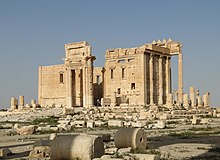Temple of Bel: Difference between revisions
| Line 40: | Line 40: | ||
==History== |
==History== |
||
The temple is built on a hill with [[Stratification (archeology)|stratification]] indicating human occupation that goes back to the third millennium |
The temple is built on a hill with [[Stratification (archeology)|stratification]] indicating human occupation that goes back to the third millennium BC. The area was occupied in pre-Roman periods with a former temple that is usually referred to as "the first temple of Bel" and "the [[Hellenistic civilization|Hellenistic]] temple". The walls of the [[temenos]] and [[propylaea]] were constructed in the late first and the first half of the second century AD. Most of the [[Corinthian order|Corinthian]] columns of the inner [[colonnade]]s still show pedestals where the statues of the benefactors stood.<ref name="Kaizer"/> The temple is aligned along the eastern end of the [[Great Colonnade at Palmyra]]. |
||
==Architecture== |
==Architecture== |
||
Revision as of 17:11, 26 November 2012
معبد بل | |
 Main building of Temple of Bel | |
| Location | Palmyra, Syria |
|---|---|
| Type | temple |
| Height | 205 metres (673 ft) |
| History | |
| Material | Stone |
| Founded | 32 AD |
| Cultures | Palmyrene |
| Site notes | |
| Condition | partially ruined |
| Ownership | Public |
| Public access | Yes |
The Temple of Bel (Arabic: معبد بل) is an ancient stone ruin located in Palmyra, Syria. The temple, consecrated to the Semitic god Bel, worshipped at Palmyra in triad with the lunar god Aglibol and the sun god Yarhibol, formed the center of religious life in Palmyra and was dedicated in 32 AD.[1][2] Aedeen Cremin considers its ruins the "best preserved" at Palmyra.[3]
History
The temple is built on a hill with stratification indicating human occupation that goes back to the third millennium BC. The area was occupied in pre-Roman periods with a former temple that is usually referred to as "the first temple of Bel" and "the Hellenistic temple". The walls of the temenos and propylaea were constructed in the late first and the first half of the second century AD. Most of the Corinthian columns of the inner colonnades still show pedestals where the statues of the benefactors stood.[2] The temple is aligned along the eastern end of the Great Colonnade at Palmyra.
Architecture

The temple shows a remarkable synthesis of ancient Near Eastern and Greco-Roman architecture.[1] The temple lies inside a large precinct lined by porticos. It has a rectangular shape and is oriented north-south.[1] It is based on a paved court surrounded by a massive 205 metres (673 ft) long wall with a propylaeum. On a podium in the middle of the court is the actual temple building, the cella. The cella is entirely surrounded by a prostyle of Corinthian columns, only interrupted on the long side by an entrance gate with large steps leading from the court. The cella is unique in the fact that it has two inner sanctuaries, the north and south adytons, dedicated as the shrines of Bel and other local deities. The northern chamber is known for a bas-relief carving of the seven planets known to the ancients surrounded by the twelve signs of the Zodiac and the carvings of a procession of camels and veiled women.[4] The cella is lit by two pairs of windows cut high in the two long walls.[1][2] In three corners of the building stairwells can be found that lead up to rooftop terraces.[1]
In the court there are the remains of a basin, an altar, a dining hall, and a building with niches. And in the northwest corner lies a ramp along which sacrificial animals were led into the temple area.[2] There are three monumental gateways, of which the entry is through the west gate. These were modified by the Arabs in 1132 when they erected a bastion, and the temple was converted into a mosque,[4] which preserved it from further dilapidation.
References
Bibliography
- Gates, Charkes (2003), Ancient cities: the archaeology of urban life in the Ancient Near East and Egypt, Greece and Rome, Routledge, ISBN 0-415-01895-1, 9780415018951
{{citation}}: Check|isbn=value: invalid character (help) - Kaizer, Ted (2002), The religious life of Palmyra: a study of the social patterns of worship in the Roman period, Franz Steiner Verlag, ISBN 3-515-08027-9, 9783515080279
{{citation}}: Check|isbn=value: invalid character (help) - Cremin, Aedeen (2007), Archaeologica: The World's Most Significant Sites and Cultural Treasures, Frances Lincoln Ltd., ISBN 0-7112-2822-1, 9780711228221
{{citation}}: Check|isbn=value: invalid character (help)

